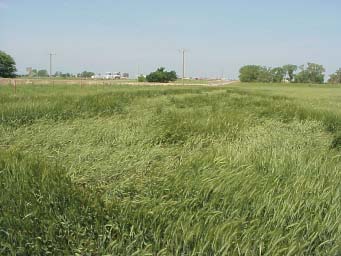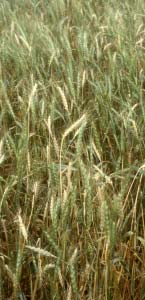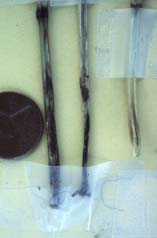Strawbreaker/Footrot on Wheat
Strawbreaker, which is caused by the fungus Pseudocercosporella herpotrichoides,
primarily over-summers on wheat residue. The fungus produces spores when humidity
is high and temperatures are around 50o F. These spores infect and colonize the base
of tillers (stems), and frequently form eyespot lesions that girdle stems and block
the transport of water and nutrients resulting in whiteheads. Basal lesions also weaken
the stems, which frequently leads to lodging especially after storms with strong winds.
| Image | Caption | |
|---|---|---|
 |
Wheat lodges in many directions | |
 |
White heads seen as wheat matures. | |
 |
Eyespot-shaped lesions are charcoal to black in color, and occur at stem bases. Lesions typically are sunken and straw is weakened and collapsed. |
Keypoint
Strawbreaker can be identified by pulling a handful of tillers from the soil. If roots pull out of the ground, then a true root rot is indicated. If tillers break at the soil surface, then strawbreaker is indicated because strawbreaker weakens the bases of tillers causing them to break at the soil line while roots stay anchored in the soil.
Strawbreaker Management
- Rotate out of wheat for a year - two years is better.
- Plant late - this alleviates strawbreaker by reducing stand density.
- There are no highly resistant varieties; however, stiffer-strawed varieties tend to resist lodging better than weak-strawed varieties.
- Fungicides (e.g., Tilt) are available, but their use in Oklahoma would not appear to be economical considering our yields and the price of wheat.
- In contrast to these measures, practices such as excessive nitrogen and high seeding rates favor strawbreaker by increasing stand density.
- Burning and deep plowing stubble have no or little affect on strawbreaker as indicated by research in the Pacific Northwest and Oklahoma.
